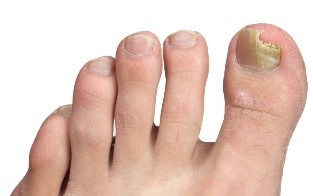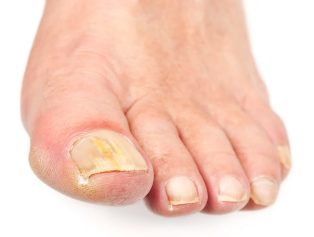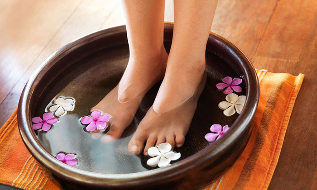A fungal infection very often the toes of the feet or nails. This disease are adults and children. To avoid a chronic pathology, it is necessary to know the signs of a fungal infection of the feet and as it is a disease.

The main signs of the disease
Among all the diseases of the skin mycosis stop is the most common. Of contracting disease, you can, by ignoring the elementary rules of hygiene. Heal the same fungus is sometimes very difficult.
Each person mycosis of the feet begins and develops differently. Here are the most common signs to recognize a fungus of the foot:
- between the toes appear to be characteristic of cracks;
- understand that there was a fungus, you can the characteristic of itching on the feet and between the toes;
- the skin stop is very dry, often it flakes and becomes rough;
- between the fingers of blisters appear, which, during the destruction erupt;
- the infection may go on the adjoining land;
- on the skin appear reddish spots that cause considerable discomfort;
- finds of fungi on the feet and unpleasant smell.
The signs of a yeast infection depending on the type of pathogen
This disease develops due to the different types of pathogens. The symptoms of lesions of the feet will be different in each case.
- If the legs develops a yeast infection of fungus, then the nail gradually becomes finer, is detached from the lodge. The skin on the sole of the foot hyperemic (takes a red tint).
- With the development of the fungus nail yellow, covered in spots. The skin of the legs is chipping off, it comes from the bad smell. A characteristic symptom of this species of fungus is to increase the dryness of the skin.
- During the onset of mold, the nail plate can radically change its color. The skin turns red, if the aetiological agent of the pathology progressively over the entire foot. The man was worried about the itching, the skin can crack. In this case, when the market appears a pain and other unpleasant sensations.
Determine the type of the pathogen can be a doctor. At home it is impossible. And if self-medication, it can't hurt. Of which will be to suffer of the feet and the skin, the fungus is becoming more and more.
The signs of some forms of mildew
Depending on the area affected and the degree of development to distinguish between several forms of pathology. The symptoms of each vary. Know the early signs of the disease of the feet, you can timely start the treatment of yeast infection.
- Interdigital Dermatophyte is the most common stage of the disease. It is activated in the spring and summer, when the feet the most sweaty. Between the fingers, appear the cracks and sores. You may notice the presence of scales on their skin. The foot appears quite healthy. Often, the person feels itching.
- Be ever wiped off the face of the form manifests itself in the less marked extent. Between the fingers significantly flaking. At this stage of the disease of the feet spreads a strong smell: it is due to an increase in the activity of the bacteria.
The disease is able to take in a variety of forms. Become familiar with their characteristics, in order to know how to determine the fungus on the legs and in the case of its development starting the treatment. It must be remembered that at advanced stages of the disease the nail is completely destroyed. Recover its almost impossible.

Flakes type
For this fungus characteristic intense desquamation of the epidermis. Being the most intense affects in particular areas of the skin between the fingers and on the side of the foot. Signs of the same inflammatory process are missing. On the photo the first signs of a fungal infection of the feet visible sites of hyperemia. Flakes of fungus looks like this:
- thickens the horny layer;
- the skin shines, sometimes thicker;
- the design on the skin becomes distinct;
- the fungus is gradually extending to the fingers, the whole foot, hits the nail;
- sometimes, on the epidermis appear platy scales;
- other unpleasant sensations the patient does not feel.
The chronic Type
When this fungus on the skin small bubbles appear, filled with fluid. Usually, they are in the lateral part of the foot. Then they drop gradually to the inner side of the fingers. How to recognize a fungus on the feet of the chronic type:
- the bubble is generally unique, but if they are numerous, they merge into a large;
- in the absence of treatment of the liquid into the bubbles gradually darkens;
- if the blister is torn, the place there is erosion of the crust.
Intertriginous type
This type of fungus is the most common. First the man does not feel symptoms. Up to a certain point, the skin on the fingers of the feet does not change. In the future, there are cracks, stratification. The skin is not affected, but it can transpire.
The defeat of fungus stop
The characteristic symptoms of this fungal of the following injuries:
- the focus of the defeat is the 3rd or 4th finger of the foot;
- the skin is red and swollen;
- around the lesion is a bubble, where there is a stratified layer of the skin;
- nearby are pustules, vesicles.
The signs fungal infection of the defeat of the nails
In the man can be dazzled and nails of the feet. Distinguish the disease may be on the symptoms.
- Expressed by a change of color of the nail plate. Depending on the type of pathology of a patient from one nail takes multiple shades. Sometimes, it can change only on the part of the nail plate.
- The collapse of the nail. It happens only in advanced stages. If the nail is completely infected, it is destroyed.
- The modification of the structure of the nail.
There are several varieties of onychomycosis — fungal infection of the defeat of the nails.
- Atrophic view. The nail plate seems very thin. It is dark, sometimes acquires gray-brown color. The nail detaches himself gradually from his box. The skin under it becomes rough and loose.
- When the normotroficheskie the form of a mycosis of the feet to the plate of change of hue. On it, there are spots of white, yellow, green and even black. The structure of the nail does not suffer.
- In the hypertrophic form of the plate gradually thickens, becomes porous. A shock to the region is very ugly looks like, and in some cases, is the cause of the pain when walking. On the sides of the same, it crumbles and without treatment destroyed.

Some varieties onychomycosis
Depending on the degree of spread of the disease to secrete its forms.
- Onychomycosis is the most common. On the free edge of the nail, first you get a small yellow spot. In the following, you can notice how it increases, and the nail plate thickens. During the walk, you feel a malaise. Obviously the bad smells. Onychomycosis is difficult to treat.
- The surface onychomycosis, is a characteristic of the defeat, only the upper layers of the plate. It does get thicker, but with time, becomes like chalk.
- The more rare the disease is subungual onychomycosis. The skin is visibly thickens in the fold of the nail. The nail turns whitish and loses its transparency.
Risk group
In fact, to "catch up" to the fungus, you might be anywhere — even at home. But in the common areas, of course, the odds are much longer (if not caution).
Who is at risk?
More of catching a fungus may people with the following diseases:
- Flat feet and deformity of the feet.
- A poor blood circulation.
- Increased sweating of the feet. Often, the fungus "hang on" athletes and military personnel who, because of the nature of the work on foot, in the narrow or uncomfortable shoes, even in the heat.
- The presence of corns of the feet, as well as the people, coarse and thick skin of the feet.
- Low immunity.
- The presence of chronic diseases.
- Frequent injuries of the skin around the nails or them the nail plate. This category lovers of pedicure in the salon or the people ngligeant not the rules of hygiene.
- Diabetes mellitus.
General principles of treatment
While the treatment of the pathology starts with the diagnosis. Only after that can be a remedy. Self-medication is usually leads to a deterioration of the condition of the feet. Become familiar with the most common ways of therapy.
- The first signs of the fungal lesions, apply varnish, adhesives, ointments, sprays. It is necessary to use long-term and according to the instructions.
- The ineffectiveness of local treatment prescribed an antifungal medication integrated action. They are used by oral route.
- The surgical removal of the infringement of the nail.
- Laser therapy.
- In its advanced form of the disease prescribed systemic medications.
To avoid the occurrence of bad condition may, in accordance with the rules of hygiene. It is necessary to avoid the use of foreign media personal linen (towels, slippers). At the onset of the first signs of the disease should immediately consult a physician.
The 10 best remedies for nail fungus

In case of suspicion on the nail fungus, simultaneously with the treatment of a specialist, you can apply one of the popular methods. Is not recommended to go to the place of treatment, the doctor may make the problem worse, and then the healing process will be really long and exhausting.
So, what are the means have come down to us by our grandmothers and great-grandmothers?
- Regular nail treatment is one of the following tools: propolis tincture, antiseptic properties of tea tree oil, apple cider vinegar.
- Foot baths.You can use sea salt (preferably without additives), the infusion of celandine, yarrow, st. john's wort, oak bark, chamomile, calendula, and other After the bath it is necessary to grease the nail with lemon juice, iodine or apple cider vinegar.
- Iodine. The essence of treatment: twice a day applied on the damaged nail (within 20 days) 1-2 drops of iodine. In case of success of the treatment then moving on to a treatment of 1 times in 3 days.
- The kombucha. Its infusion is used as a compress. It is enough to soak the gauze, apply a compress and leave overnight in the polyethylene and socks. You can also apply directly a part of kombucha nail, then wrap them and leave them for a few hours. After — steam the legs, and apply the mixture of cider vinegar (part 1), 96% alcohol (2 parts), glycerin (2 parts). Leave it on all night. The course of treatment is 2 weeks.
- The garlic oil.Fill in the rubbed garlic hot sunflower oil until the complete covering of the garlic. Mix everything, close tightly and insist 2 days. Gas treatment: wet cotton in the oil, apply it to the patient of a website, do a dressing, protecting top of polyethylene, put on socks and keep them for the night. Course of 2 weeks.
- Vinegar.Wet cotton in the vinegar (9%), apply to the sick of the parcel, wrap the polyethylene, fix a bandage and leave overnight. The morning repeat.
- Soda with the celandine. Smoke your feet in the solution (3 l of water + 1)/l, bicarbonate of soda), we do wipe off the feet, the oil patients areas with the fingers of the oil of celandine (look at the pharmacy). Course of 2 weeks.
- The birch tar. Smoke the feet with the help of the prod/soap (approximately 20 minutes), clean the feet with a pumice stone, hit nails, we wipe to dry the feet and oil nails with the fingers of birch tar. Put the feet on the log for 1.5 hours and read the book. Then, remove the excess of black tar, put x/b socks and forget the feet on a couple of days. On the tip of my feet again with the prod/soap and cool water. In the evening, we repeat the procedure. Course of 2 weeks.
- Kalanchoe. Treatment: on the non-color nail glue to help patch the leaves of kalanchoe to cover them with nail holes. The patches with the leaves changing every day. Course — 2-3 weeks.
The measures of prevention of nail fungus
Protect the mold, you can by simple compliance with the rules of hygiene, and timely preventive measures.
Remember:

- All the public spaces (beaches, shower, dressing room, swimming pool, spa etc) put easily washable slippers. Do not walk barefoot where there is the risk of getting an infection!
- Do not put someone else's shoes (including slippers on the move — better to have the air in the socks).
- We do not serve foreigners, towels and nail grooming.
- Coming out of the bathroom, put the feet are not on the common (and often humid, is not the first freshness, carpets), and its the same towel (in advance, select the under of such objectives).
- Regularly, we examine the feet and nails about the appearance of the signs of mold. At the slightest of symptoms (there were cracks and itchiness between the toes, discoloration of the nail, etc) take action. That is, we buy ointments, spcialiste varnish etc
- Try not to use tight, narrow shoes and shoes with materials of inferior quality.
- Regularly treat your shoes to the inside of the conservatives.
- Your feet are not sweating, use deodorants, talc, etc
- Only use x/b socks. If necessary, the use of tights/stockings (produced from nylon and other synthetic fabrics, of the house of their remove, smoke the feet, the process.
- In the heat wear open shoes for the ventilation and air-free. The sweating of the feet — to-ground for bacteria.
- Not measure the shoes in the stores without sock/traces— of socks.
- Dry we wipe the feet after bathing, including the spaces between the fingers — this is where begins the fungus.
- Don't allow cracks on the feet, use moisturizers.
- The feet of my antibacterial mild soap.
- At high risk of infection (for example, on holiday or in the swimming pool), apply anti-fungal cream, powder or aerosol.
- Carefully dry the shoes, if it is wet. Do not put damp shoes or boots.
- Choose exclusively proven in salons and pedicure/manicure.
- Don't let ingrown and deformation of the nails — let's take action in a timely manner.






























